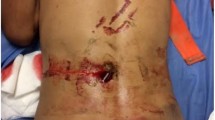Abstract
Traumas are the most important cause of mortality in the pediatric population. Bleeding is an important complication, especially in traumatic brain injuries with coagulation problem addition. Low-velocity penetrating brain injuries may be caused by sewing needles, nails, and knives. There are few studies in the literature for this injury type. This study presented a surgical technique and treatment to increase hemostasis in a 2-year-old patient after a sewing needle injury.


Similar content being viewed by others
References
Young M, Putty M, Finneran MM et al (2020) Multidisciplinary management of low-velocity nonmissile penetrating head ınjuries. Cureus 12:e7388. https://doi.org/10.7759/cureus.7388
Talving P, Lustenberger T, Lam L et al (2011) Coagulopathy after isolated severe traumatic brain injury in children. J Trauma 71:1205–1210. https://doi.org/10.1097/TA.0b013e31820d151d
Peiniger S, Nienaber U, Lefering R et al (2012) Trauma registry of the Deutsche Gesellschaft für Unfallchirurgie. Glasgow Coma Scale as a predictor for hemocoagulative disorders after blunt pediatric traumatic brain injury. Pediatr Crit Care Med 13:455–460. https://doi.org/10.1097/PCC.0b013e31823893c5
Gutiérrez-González R, Boto GR, Rivero-Garvía M et al (2008) Penetrating brain injury by drill bit. Clin Neurol Neurosurg 110:207–210. https://doi.org/10.1016/j.clineuro.2007.09.014
Sweeney JM, Lebovitz JJ, Eller JL et al (2011) Management of nonmissile penetrating brain injuries: a description of three cases and review of the literature. Skull Base Rep 1:39–46. https://doi.org/10.1055/s-0031-1275257
Kazim SF, Shamim MS, Tahir MZ et al (2011) Management of penetrating brain injury. J Emerg Trauma Shock 4:395–402. https://doi.org/10.4103/0974-2700.83871
Borkar SA, Garg K, Garg M et al (2014) Transorbital penetrating cerebral injury caused by a wooden stick: surgical nuances for removal of a foreign body lodged in cavernous sinus. Childs Nerv Syst 30:1441–1444. https://doi.org/10.1007/s00381-014-2364-0
Bodwal J, Sreenivas M, Aggrawal A (2013) Intracranial penetrating injury by screw driver: a case report and review of literature. J Forensic Leg Med 20:972–975. https://doi.org/10.1016/j.jflm.2013.09.010
Gökçek C, Erdem Y, Köktekir E et al (2007) Intracranial foreign body. Turk Neurosurg 17:121–124
Morrison JJ, Dubose JJ, Rasmussen TE et al (2012) Military application of tranexamic acid in trauma emergency resuscitation (MATTERs) study. Arch Surg 147:113–119. https://doi.org/10.1001/archsurg.2011.287
Naoulou B, Tsai MC (2012) Efficacy of tranexamic acid in the treatment of idiopathic and non-functional heavy menstrual bleeding: a systematic review. Acta Obstet Gynecol Scand 91:529–537. https://doi.org/10.1111/j.1600-0412.2012.01361.x
Beno S, Ackery AD, Callum J et al (2014) Tranexamic acid in pediatric trauma: why not? Crit Care 18:313. https://doi.org/10.1186/cc13965
McLeod LM, French B, Flynn JM et al (2015) Antifibrinolytic use and blood transfusions in pediatric scoliosis surgeries performed at US Children’s Hospitals. J Spinal Disord Tech 28:E460–E466. https://doi.org/10.1097/BSD.0b013e3182a22a54
Grassin-Delyle S, Couturier R, Abe E et al (2013) A practical tranexamic acid dosing scheme based on population pharmacokinetics in children undergoing cardiac surgery. Anesthesiology 118:853–862. https://doi.org/10.1097/ALN.0b013e318283c83a
Stokes ME, Ye X, Shah M et al (2011) Impact of bleeding-related complications and/or blood product transfusions on hospital costs in inpatient surgical patients. BMC Health Serv Res 11:135. https://doi.org/10.1186/1472-6963-11-135
Kamamoto D, Kanazawa T, Ishihara E et al (2020) Efficacy of a topical gelatin-thrombin hemostatic matrix, FLOSEAL®, in intracranial tumor resection. Surg Neurol Int 11:16. https://doi.org/10.25259/SNI_272_2019
Acknowledgements
We would like to thank the pediatricians who were not included in the article’s list of authors, but had an important place in the patient’s treatment. Preparation for publication of this article is partly supported by the Turkish Neurosurgical Society.
Author information
Authors and Affiliations
Contributions
Şahin MH: responsible for the idea of the whole article. Zeynal M: figure arrangement and was part of the surgical team.
Corresponding author
Ethics declarations
Ethical approval
The eyes images were closed. There was no part of this article that needed ethical approval. Written permission was obtained from the parent’s parents for the use of the images in a scientific article.
Informed consent
The consent form was obtained from the patient’s parents because his face was partially visible.
Conflict of interest
There are no conflicts of interest.
Additional information
Publisher's Note
Springer Nature remains neutral with regard to jurisdictional claims in published maps and institutional affiliations.
Rights and permissions
Springer Nature or its licensor (e.g. a society or other partner) holds exclusive rights to this article under a publishing agreement with the author(s) or other rightsholder(s); author self-archiving of the accepted manuscript version of this article is solely governed by the terms of such publishing agreement and applicable law.
About this article
Cite this article
Şahin, M.H., Zeynal, M. New surgical technique for non-missile trauma hemostasis as a result of sewing needle. Childs Nerv Syst 39, 781–785 (2023). https://doi.org/10.1007/s00381-023-05831-5
Received:
Accepted:
Published:
Issue Date:
DOI: https://doi.org/10.1007/s00381-023-05831-5




